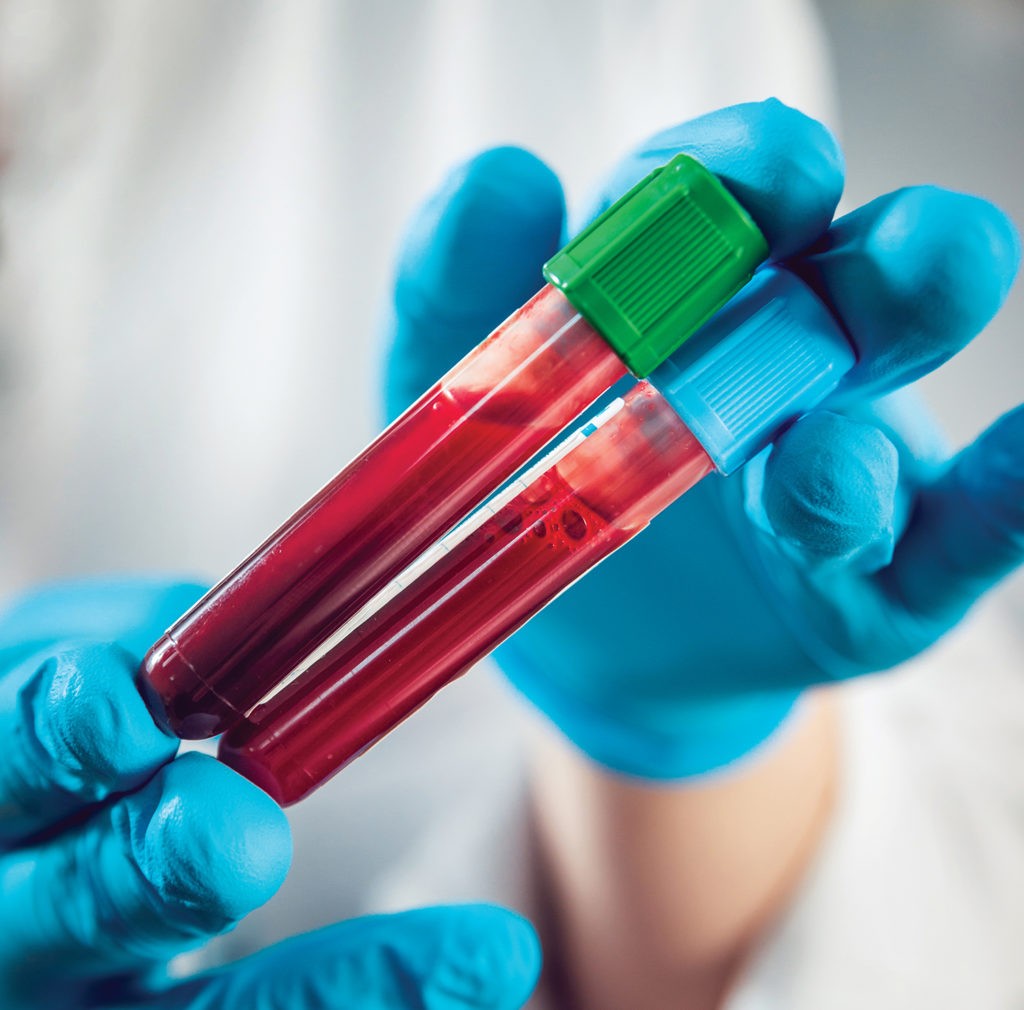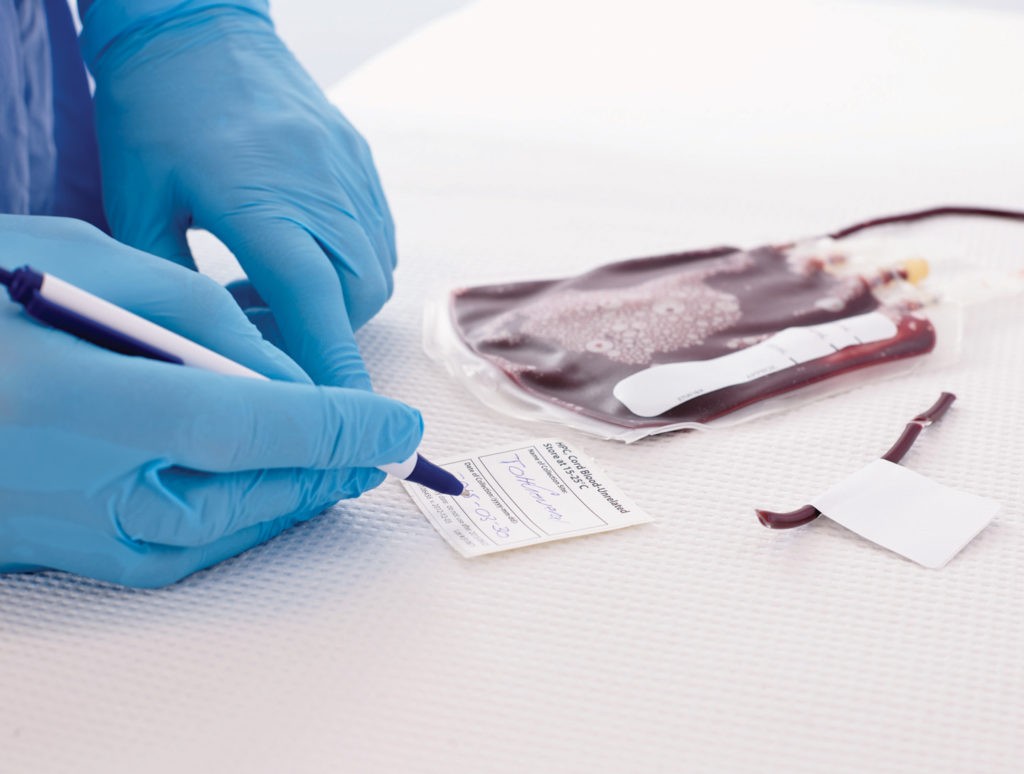Cord Blood’s Therapeutic Potential

July is Cord Blood Awareness month, and a closer look shows that there is much potential as well as much work to be done in educating the public about cord blood donation.
The birth of a child can change the lives of the family forever, and medical research is finding that it can save another life as well. Cord blood, or the blood that remains in the human umbilical cord and placenta after birth, is a rich source of hematopoietic progenitor cells, or stem cells, the precursors of all other blood cells, and the perfect cells to transplant to treat many life-threatening diseases.
Bone marrow from donors has traditionally been the primary source of stems cells used for the restoration of diseased marrow, but research has found that cord blood is an excellent and often preferred source. While holding tremendous potential, there remains some important barriers in understanding, as well as barriers to banking.

THE POWER OF CORD BLOOD
From the parent’s perspective, everything about pregnancy, birth, and a new life is absolutely amazing, and it truly is. From a medical perspective, the birth of a baby has an added element of excitement and potential in cord blood stem cells and the host of diseases they are used to treat.
Cord blood stem cells are exciting because they hold so much potential. They are biologically younger and more flexible when compared to that extracted from adult bone marrow, and considered immunologically naïve because they have not been exposed to infections. This makes them more tolerant of a tissue mismatch between the cord cells and the patient. They can be used to transplant patients who do not have a fully matched available donor.
They also possess unique qualities that, when banked, offer important advantages, such as posing less risk of complications when used in transplants.
CORD BLOOD TRANSPLANT HAS A LONG HISTORY

Most people do not realize that cord blood transplants have been in use for many years, according to Dr. Kelley Young, medical oncologist serving several hospitals in the Kansas City area. “The use of cord blood as treatment has been around for over 30 years, and the use of bone marrow stem cells even longer than that,” she explained.
Dr. Eliane Gluckman performed the world’s first cord blood transplant in 1988 on a patient with severe aplastic anemia, and since that time there have been over 35,000 cord blood transplants worldwide. Astonishingly, many people still remain unaware of cord blood’s therapeutic potential or the process of banking it.
Cord blood, as a biological product, is regulated by the Food and Drug Administration and approved for use in hematopoietic stem cell transplantation procedures which are done in patients with disorders affecting the hematopoietic or blood forming system.
“Today, cord blood stem cells are used in the treatment of over 80 diseases that include blood disorders such as Aplastic Anemia and Sickle Cell Disease and cancers such as Leukemia, Non-Hodgkin’s Lymphoma, and Multiple Myeloma. It is also used to treat immune disorders such as Adenosine Deaminase Deficiency (SCID) or metabolic disorders such as Hunter Syndrome (MPS-II), and Tay Sachs,” Young continued.
Transplantation is nonsurgical; the infusion of stem cells similar to receiving a blood transfusion. “While simple, it is an intensive therapy that can require a lengthy hospital stay. The advantage to using cord blood is that it does not have to be as closely matched as bone marrow and the incidence of Graft Versus Host Disease (GVHD) is less and less severe when using cord blood donation.”
ABOUT CORD BLOOD BANKING
The process of collecting cord blood is simple and does not pose any risk, discomfort, or inconvenience to the donor. Once collected, it is frozen and stored carefully to protect the integrity of the cells. Parents may choose to store the baby’s cord blood in a private bank for use by the child, siblings, or first or second-degree relatives should the need arise. Another option is to donate the cord blood to a public bank, much like a blood bank, for doctors to use for a matching patient needing a stem cell transplant.
FDA REGULATIONS
Depending on the source, level of processing, and intended use, cord blood is regulated differently. When collected and stored for personal use and when meeting FDA regulations, it does not require the agency’s approval before use and is categorized a biological product.
In the treatment of an unrelated patient, cord blood must meet additional FDA requirements and be licensed under a biologics license application, and meets the definition of both a “biological product” and a “drug” to ensure the safety of the product and minimize any risks of contamination and the transmission of infectious diseases.

COMMON MISCONCEPTIONS
There are many emotions surrounding cord blood banking and those emotions often fuel decisions surrounding the decision to bank cord blood. But those emotions can also lead to many misconceptions, including a misunderstanding of the likelihood of personal need, or a misunderstanding of treatment possibilities.
According to the FDA, cord blood is not a cure-all.
“Because cord blood contains stem cells, there have been stem cell fraud cases related to cord blood. Consumers may think that stem cells can cure any disease, but science doesn’t show this to be the case. Patients should be skeptical if cord blood is being promoted for uses other than blood stem cell regeneration.”
Studies also show it is highly unlikely that the cord blood stored for family use will ever be used for their child. However, clinicians strongly support donating cord blood to public blood banks with national and international reach, increasing the likelihood of it benefiting a match.
“People do not understand, for example, that pediatric leukemia, the fear of which is one of the most cited reasons to privately bank cord blood, is most often and successfully treated with chemotherapy alone and cord blood transplant is not necessary,” Young added.
According to statistics from the National Institutes of Health, roughly 1 in 100,000 children have a chance of getting acute leukemia. Then, 85% of those 1 in 100,000 are cured with chemotherapy alone.
THERE ARE SOME UNFORTUNATE BARRIERS
Awareness tops the chart as one of the most significant barriers in cord blood donation and banking. Obstetricians and other health care professionals are likely the patient’s primary source of medical information affecting the mother and baby. For this reason, these professionals are recognized as pivotal in providing information and guidance in public and private cord blood banking.
Despite its value in the treatment of many diseases, cord blood is not routinely harvested. Currently, cord blood is considered medical waste and 95% of this life-saving material is promptly disposed of –– in the trash –– unless there is some intervention. It is only saved if the birth mother decides to save the cord blood for her own family in a private bank or decides to donate it to a public cord blood bank.
There are also other barriers. Not every hospital participates in cord blood banking and those that do may not be on the insured’s plan. Additionally, there remains a huge need among minorities.

REGISTRY AND COOPERATION
When cord blood is donated to a public bank, it becomes part of a registry and is available worldwide. There are over 130 public cord blood banks in 35 countries; they are regulated by governments and adhere to internationally agreed safety, quality, and ethical standards.
“This is one area of medicine that has seen an incredible amount of international cooperation, and it is quite positive,” Young furthered.
Be The Match®, operated by the National Marrow Donor Program® (NMDP) manages the largest and most diverse marrow registry in the world. The organization manages a global transplant network comprised of more than 600 leading centers worldwide, all partnering to support donors and patients.
THE FUTURE OF CORD BLOOD
Studies continue and cord blood may prove critical to new areas of regenerative medicine to potentially treat spinal cord injuries, cerebral palsy, autism, type 1 diabetes and more. Regenerative therapy, or the practice of cells and cell product to diseased and damaged tissues, is an area of medicine that is quickly growing and the subject of intensive medical research. Each year, new therapies are being tested using stems cells extracted from cord blood and enter clinical trials to treat an expanding base of life-threatening diseases. Currently, there are over 350 clinical trials in progress testing the efficacy of umbilical cord blood and tissue for transplantation in the treatment of serious diseases such as ALS or Lou Gehrig’s disease and Alzheimer’s. If these therapies are proven beneficial, the trials lend to approval by the Food and Drug Administration. Once these treatments gain FDA approval, they can then move from trial stage to be administered as general practice. The process is long and arduous, but we are just beginning to discover its potential.
TIPS FOR CONSUMERS
If you are considering donating to a cord blood bank, look into your options as early into the pregnancy as possible in order to have as many options as possible. For public banking, you will need to ask if your delivery hospital, or one covered by your insurance, participates in a cord blood banking program. Be sure to let your physician know of your plans so they can help review your options.
When considering the emerging and continued research, the future of stem cell treatments looks bright. It is important that we keep the conversation going. We here at Health Kansas City magazine ask that you talk about cord blood donation with friends and family. In doing so, you just might save a life.
For more information about cord blood donation and treatment, we invite you to visit these sites:
FDA: www.fda.gov (search cord blood)
World Cord Blood Day: www.worldcordbloodday.org
National Cord Blood Program: www.nationalcordbloodprogram.org
American Health Council: https://americanhealthcouncil.org/cord-blood-awareness-month






